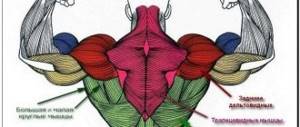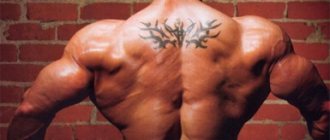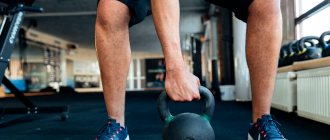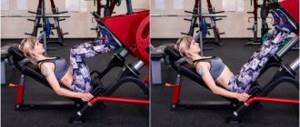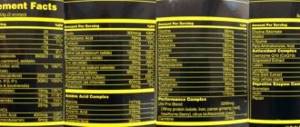How to build a wide back and shoulders? Is it possible to pump up the latissimus muscles on the horizontal bar? How to make a wide back at home or in the gym? All these questions are asked, as a rule, by novice athletes who have only recently connected their lives with bodybuilding. Their interest in back muscles is not surprising: almost every athlete knows that a wide back is the calling card of many bodybuilders. Not biceps, not legs, but back. In today's article we will tell you how to pump up the latissimus dorsi muscles with dumbbells, a barbell and a horizontal bar. This article will be of interest to those who train at home, and to those who work out in a gym or fitness center. Interested? Then enjoy reading!
General facts and recommendations
Some people are interested in how to make their back and shoulders broad. Others, on the contrary, do not understand why this is necessary. Someone might ask: “Why bother training your back muscles at all?” Why do you need to spend time working on this muscle group if you can spend more time, for example, on the same biceps or abs? The answer is simple: training your back is necessary not so much for aesthetic beauty, but for health. The fact is that our spine and back muscles are heavily loaded during movement, heavy physical activity and when performing many exercises. On top of that, the latissimus dorsi muscles are involved in the movement of our upper limbs. Therefore, it is necessary to address the issue of strengthening these muscle groups in time, especially when you go to the gym, where there are all the necessary conditions for this.
To make your workouts as productive and safe as possible, you need to know a number of rules and recommendations:
- Be patient. It’s worth saying right away that you won’t be able to pump up a wide back quickly. Many inexperienced athletes are often fooled by charlatan advertising ploys that promise them a perfect body in one week. In fact, it is simply impossible to achieve any success in such a short period of time. If you decide to take up bodybuilding, then you should be prepared for the fact that at first your results will be quite modest. It’s important not to get disappointed and not give up halfway. Only persistence and hard work will help you achieve your goals!
- You don't need to train every day. This applies not only to the back muscles, but to all your muscles in general. If your goal is to gain muscle mass without taking illegal steroid drugs, then you need to train your back 1 (maximum 2) times a week. Between heavy and grueling strength training, you definitely need to take a break of 1-2 days. This period of time is necessary so that your muscles and central nervous system have time to fully recover.
- Don't train just your back. Another serious mistake beginners make is overemphasis on any particular muscle group. If you want to know how to get a wide back in the gym, then you should also know how to train other muscles in your body. Remember that you can only achieve a beautiful and athletic physique if you train your entire body.
- Do a full warm-up before your training session. Many beginners who are interested in how to create a wide back for some reason forget about such an important training aspect as warming up. Some novice athletes do not do it on principle, arguing that it takes away strength and energy that could be spent in training. In fact, this is a big misconception. In strength sports (especially when it comes to the back muscles), it is necessary to warm up before each session. Warming up improves muscle performance and helps avoid serious injuries.
- Increase the load. In order for the muscles in your body to grow, progression of loads is necessary. If you feel that an exercise is too easy for you (for example, you can do 15-20 pull-ups without any problems), then this indicates that you need to increase your training weight. Remember that as your strength increases, so does your muscle mass.
- Don't neglect rest. Many fitness and sports experts recommend taking a break from training for 1-2 weeks every 3-4 months. Also, do not forget about unloading workouts - less intense and voluminous than usual.
- Follow the regime. As mentioned earlier, recovery plays a huge role in bodybuilding. The fact is that our muscles grow during rest, and not during training. In order for the muscles to have time to fully recover before the next session, you need to sleep at least 8 hours a day, and it is advisable to go to bed and wake up at approximately the same time.
- Eat right. This applies to both thin and overweight guys. Whatever one may say, eating buns, fast food and lemonade, you will not be able to build a beautiful and athletic physique.
- Do everything technically. Proper technique is the key to success and safety. Before you start performing an unknown exercise, make sure that you are thoroughly familiar with its technique and take into account all the nuances. This is especially true for basic exercises in the gym, which, if performed incorrectly, can seriously harm joints and tendons.
- Don't forget about breathing. This aspect is also not given as much attention as we would like. When breathing incorrectly, an athlete's blood pressure increases, which, in turn, leads to a sharp deterioration in performance. Remember: you must exhale during the effort, and inhale in the negative phase (for example, when lowering the projectile).
- Follow the program. To achieve maximum results in bodybuilding, you need to create a competent training program. Chaotic and inconsistent activities will not lead to anything positive; discipline and regularity are important in this matter. In training systems, as a rule, one muscle group is trained on the same day as another. For example, it is best to train the back muscles on the same day as the biceps, the pectoral muscles with the triceps, and the shoulders with the legs. This complex can be done both in the gym and at home.
- Concentrate on the necessary muscles while working. A fairly common situation: a person does an exercise on one muscle group, and in the end, feels tension in a completely different one. For example, when doing pull-ups with a wide grip, the athlete feels the biceps instead of the lats. Whatever one may say, it is not possible to completely turn off the biceps from the work in exercises of this type, however, the main load should go directly to the back. To achieve this, you need to bring the technique of performing each exercise to perfection. It is most convenient to do this with light weight.
Back Depth
A sculpted back is created by exercises in which weights are pulled horizontally to the abdomen . Such exercises include lat pull-downs, bent-over barbell and dumbbell rows, horizontal hummers, etc. As for everyone’s favorite deadlift, you need to understand that this exercise works well on the muscles of the legs, buttocks and back. However, its main impact is on the spinal extensors, so it is not suitable for creating depth to the bulk of the back.
Static “squeezing” during sets will also help create depth in your back. A full contraction and a short pause should be performed in each repetition, and the weight should be held using the back muscles, not the arms.
The main mistake when doing exercises for the back muscles is thoughtlessly pulling weights from point A to point B, using jerks or using the biceps. This is often observed in gyms among inexperienced visitors. It is very important to learn to feel the work of your back, so in all pulling movements, you need to concentrate and pull with your elbows. Each exercise should begin with lowering the shoulder blades, then the humerus should be retracted and the shoulder blades should be fully retracted. By performing isolated exercises in a short amplitude, you can also minimize the load on the biceps.
When working with relatively heavy weights, I recommend using pull straps or special iron hooks. This will help to significantly reduce the load on your arms and fully concentrate on working your back muscles.
And don't forget about diet. All the muscles are prominent, but the fat layer and large accumulation of fluid in the body make it difficult to see.
Goals and objectives of the training, indications and contraindications
Before you start training, you need to decide on your goal. If you want to build a beautiful and voluminous back, you should work out very hard and be determined to complete the following tasks:
- Exercise regularly without missing classes.
- Constantly progress in weights in order to stimulate muscle growth.
- At the same time as your back, pay attention to the antagonist muscles, in this case the pectoral muscles. Sagging of this muscle group can slow back growth.
If your goal is to strengthen your back muscles, then it will be enough to perform the presented exercises in a lighter version.
Back muscle training is recommended for people of all ages if they want to improve their health and get their bodies in order. But training with heavy weights is prohibited for people with:
- problems with the musculoskeletal system.
- chronic diseases of the cardiovascular system.
- the course of any pathology in acute form.
Anatomy of the lats
How to pump up a wide back at home or in the gym? It's simple: focus on your lats! The fact is that these muscles are responsible for the width of our back. Well-developed lats are also called "wings" due to their visual resemblance to bird limbs.
The wings start from the vertebrae of the sternum and extend to the lumbar and sacrum areas. The upper bundles of the broadest are distinguished by the lateral course, and the lower ones - by the lateral and superior ones. On top of that, there are also additional tufts - teeth that cover the shoulder blades.
We have already dealt with the general facts, now let's move on to the main topic of today's article, namely, exercises for a wide back at home and in the gym. Let's start with pull-ups.
Training principles for a wide back
The back muscles are usually divided into three parts:
- The top is formed mainly by trapezoids.
- The middle part is the most massive part, represented by the widest.
- Lumbar region.
Many movements involve the upper and middle parts. Therefore, there is no need to work on each area separately. The lower back is usually worked with general movements (like deadlifts), as well as focused ones with the help of hyperextensions.
If we consider a wide back in men as the goal of training, then the main emphasis should be on the latissimus muscles. However, it should be remembered that training cannot influence only the width or thickness. The shape of each person's muscles is determined by genetics. With the help of physical activity, you can increase the muscle in volume, from which it will not grow in width, but increase in size, depending on its shape.
Therefore, any attempts to purposefully expand the back beyond one’s genetic potential will not be successful; it is simply impossible. This means that any specialized exercises for the width of the back will reduce the overall effectiveness of the training.
Basic rules for back training:
- Train the group once a week, allowing 4-5 days for full recovery.
- Prioritize your back in splits (for example, in the classic chest/back version).
- Focus on exercises that engage as many muscle fibers as possible (that is, basic and compound movements).
- Remember the main rule for maintaining the effectiveness of the exercise - your back should be straight.
- Learns to tense the latissimus muscles (an important element in increasing the efficiency of movements).
On the subject: Latissimus dorsi muscle torsion
You should also provide a powerful stretch to the muscles. In order to make the back wider and fully utilize the lats, taking into account their functions, the movements must involve shoulder work (the rear deltoid is primarily responsible for this). The indicator is the shoulder blades; at the top point in most exercises they should converge, at the bottom point they should diverge, with a slight drop in the shoulder (this will give the desired stretch). Whether you're doing wide back exercises at home or at the gym, you almost always end up doing some stretching at the end of the session.
Pull-ups: variations and types of exercise
How to pump up the latissimus dorsi muscles on the horizontal bar? This question can be heard very often from novice athletes. This is not surprising, since pull-ups on the bar are one of the most accessible exercises of all.
It’s worth saying right away that if you are working on muscle growth rather than endurance, then you need to work with additional weights. When the number of your pull-ups reaches 15-20 times in one approach, then you can begin to put additional weight on yourself. This could be an ordinary briefcase filled with dumbbell plates, books, bottles, etc.
Before learning how to pump up the latissimus dorsi muscles on the horizontal bar, we recommend that you watch the video below (in case you cannot do a single pull-up):
Grip plays a big role in pull-ups. Your grip and hand position will determine which muscle group you will work the most. Below we have discussed the most common and most effective grips.
1. Wide-grip chest pull-ups. This type of pull-up is aimed at working the trapezius, teres, infraspinatus, and upper part of the latissimus muscles. This exercise is done this way:
- Grab the bar with a wide grip.
- As you exhale, pull yourself up so that the upper part of your pectoral muscles touches the horizontal bar. At the top point, squeeze your shoulder blades together. Relax your biceps. The back should be arched at the top.
- Take a short pause in this position, then, inhaling, slowly lower yourself to the starting position.
2. Pull-ups with a wide grip behind the head. It’s worth saying right away that pull-ups with such a grip are not designed for everyone. If you have any problems with the shoulder joints, then it is completely contraindicated for you. To avoid injury, it is better not to overuse such exercises. Remember that safety must come before efficiency!
Wide-grip pull-ups work the trapezius, teres, infraspinatus, and upper and middle latissimus dorsi muscles. They are great for those people who were interested in the question of how to make the upper back wider.
Technique:
- Grab the bar with a wide grip.
- Exhaling, slowly rise up, keeping your entire body strictly perpendicular to the floor. The elbow joints should be pointing down.
- At the top point, the horizontal bar should be behind your head.
- Inhale and lower yourself into IP.
3. Pull-ups with a medium straight grip. The most common type of exercise. Suitable for almost all athletes - both experienced and beginners. When performing this exercise, the back muscles, biceps and shoulder muscles are worked.
Pull-ups are performed with a medium straight grip as follows:
- Grasp the bar so that your hands are shoulder-width apart.
- As you exhale, bringing your shoulder blades together, pull yourself up so that your chin at the top point is higher than the bar (it is advisable to touch the horizontal bar with your chest).
- As you inhale, slowly lower yourself down.
4. Pull-ups with a narrow straight grip. How to pump up the lower latissimus dorsi muscles? If you are interested in this question, then you are very lucky! Close-grip pull-ups work the lower lats, as well as the serratus and brachialis muscles.
Technique:
- Grasp the horizontal bar with a narrow grip.
- As you exhale, bend your back and slowly pull yourself up to the bar using the same principle as in the previous version.
- Inhaling, lower yourself to the starting point.
Functions of the back muscles
The back is the second largest muscle mass after the legs. Pumping these two groups along with the pectoral muscles gives maximum weight gain. To know how to train your back for weight, you need to understand what functions it performs.
There are three main groups training in the gym:
- Trapezoid. Fixes, raises, lowers and brings the scapula to the spine. Participates in bending and moving the head back.
- Latissimus muscles. Bring the shoulder towards the body and participate in traction movements towards the middle of the body.
- Extensors. They participate in tilting the body and turning the head, straightening the back, and maintaining the body in an upright position.
By developing these muscle groups, you will get a strong and wide back. Now let's talk about how to do this.
Deadlift
How to pump up a wide back on the horizontal bar? We think that this question is already clear. A horizontal bar is a universal piece of equipment that can and should be used by everyone: both street athletes and visitors to fitness centers. So how to get a wide back using gym equipment? Let's find out!
You can start with deadlifts. This is a basic exercise that uses several muscle groups at once. We can say that this is the most important and important exercise for the development of the lumbar and latissimus muscles, as well as the hamstrings. In total, the following types of deadlift can be distinguished: classic and sumo. There is also half sumo, which is an intermediate option, but, as a rule, everyone focuses on the previous two.
Differences between classic and sumo:
- in the classics, the barbell must be pulled through almost the entire amplitude of movement up to the top point;
- in sumo, the lion's share of the effort comes from the breakdown: it was pulled off, passed the dead point, and then the projectile, by inertia, having passed through a short amplitude, is already at the final point.
Who is more suited to classics and who is more suited to sumo?
- classic - for those athletes who have balanced development of both the back and legs. In addition, it is important that the back is able to withstand sufficiently large loads;
- sumo - for those athletes who have better developed legs and can make great explosive efforts;
The execution technique in both cases is essentially the same:
- Grab the bar with an overhand grip at shoulder level (or slightly wider) and squat down so that your pelvis is tilted back as far as possible. This will keep your shoulders and knees from extending beyond the bar. The shoulder blades must be brought together and the shoulders must be moved back beyond the bar.
- The legs must be kept bent, the gluteal muscles pulled back as much as possible, the back straightened and slightly tilted, the shoulders straightened, and the knees not moved beyond the bar.
- The whole body must be tensed as much as possible, the hands must hold the projectile with all their might. As you exhale, you need to pull the bar up in a single explosive movement.
- Having fixed in this position, while inhaling, lower the projectile under control to the starting position.
Technique for performing classic deadlifts:
Despite its effectiveness, the deadlift is a very traumatic exercise if performed incorrectly. That is why it is extremely important to do it with the most correct technique and not chase the scales.
Horizontal chest pulldown
The exercise falls into the category of basic exercises for working the latissimus dorsi muscles. The training is performed on a simulator in the form of a cable with handles connected to a pulley.
First, take a sitting position, turning around to face the sports equipment. The back is held in position according to its natural curves. The feet rest on the platform. The exercise machine is pre-adjusted to a comfortable height and a comfortable weight is set.
The handles of the device are grasped with your palms. After inhaling, perform cable traction in the direction of the chest. The elbows are pulled back, pressing against the body. As you exhale, relax your arms and move to the starting position. They resort to training every other day. Following this schedule allows you to achieve the desired result in the shortest possible time.
Bent-over barbell row
This exercise greatly increases the size of the lateral muscle and pumps up the teres major, rhomboid and trapezius muscles.
Technique:
- Grasp the barbell with an overhand grip and a slight incline. The lower its angle, the more actively the latissimus muscles work. Just like when performing deadlifts, your back should be as straight as possible!
- Bend forward, press your elbows in and, as you exhale, pull the barbell toward your body. At the top point, tighten your shoulder blades.
- As you inhale, lower the projectile to the starting position.
Bent-over dumbbell row
How to pump up the latissimus dorsi muscles with dumbbells? Here we come to one of the most interesting questions of our article. When it comes to high-quality isolated training of the latissimus muscles, many professional bodybuilders prefer this exercise. To perform it you will need a dumbbell and a bench. It is done like this:
- Lean your left arm straight on the bench, bend your left leg at the knee joint and put it forward, your right leg also needs to be bent at the knee. Hold the dumbbell in your right hand.
- As you exhale, keeping your back straight, pull the bar up to chest level.
- While inhaling, lower it to its original position. After doing the required number of repetitions, repeat the same algorithm on the other side.
The technique for performing bent over dumbbell rows is described in more detail in the video below.
Pullover with dumbbell
This exercise is used both for pumping the latissimus and for working the pectoral muscles. As we said earlier, it is important to concentrate specifically on the back muscles in order to achieve maximum results.
Technique:
- Take the apparatus in your hands and lie with your back on the bench. The dumbbell must be held perpendicular to the floor.
- As you inhale, lower the projectile behind your head without bending your elbows. You should feel a maximum stretch in your lats.
- As you exhale, lift the dumbbell to the starting position.
Upper block pull
How to pump up a wide back with dumbbells, a barbell and a horizontal bar? We think this is all clear. Now we would like to tell you about an exercise that requires a block machine. The lat pulldown perfectly works the latissimus, brachioradialis, teres major, rhomboid, and biceps muscles of the arms. The scapular area of the back is maximally involved in the work. This exercise is a good alternative to pull-ups.
It is done like this:
- Sit on the machine, place your hips under the roller, place your feet in line with your shoulders. Feet should rest on the floor.
- Using an overhand grip, grasp the handle with your palms. You need to bend your elbows slightly, lower your head slightly, and fix your gaze.
- With your shoulder blades pulled together, inhaling, pull the bar behind your head until it touches the back of your head.
- As you inhale, return your arms to their original position.
Features of execution:
- The cable must always be in a vertical plane;
- Elbows must be pulled along one trajectory;
- Mentally, you need to concentrate on your back muscles, not on your working arms.
By performing the exercise with the correct technique, the entire back will be evenly loaded.
Exercises to work on back width
Wide grip pull-ups
These are our good old pull-ups. There is a crossbar in every yard, but if you don’t have a crossbar at hand, then you can do pull-ups on a tree or somewhere else. Use your imagination and you can achieve what others thought was impossible to achieve. Always start your back training with pull-ups. This is an incredibly useful exercise and is considered a basic one. At the beginning of your back training, do at least a set of maximal exercises. This way you will know where you are going and what you have come to. Be sure to remember the number of pull-ups, your motivation also depends on this. After two weeks, you will see that your number of pull-ups has increased, and you will understand that there is a result from this and you are moving in the right direction.
On the subject: How to stretch the thoracic back muscles
Technique:
Place your hands 2 times wider than your shoulders, make your grip straight and begin to pull yourself towards your chest. Some people do pull-ups behind their backs, which are even harder, but you must understand that if you pull yourself up to your chest, your amplitude will become greater. If you pull yourself up behind your back, you limit yourself at the top point, therefore you don’t have such limits towards your chest. You need to perform the exercise slowly, do not push yourself out with inertia, but perform the exercise only with your muscles. Don't use all this swinging, cheating and other crap. You do pull-ups with a wide grip, so be kind enough to do them, and not suffer through nonsense.
Important! Always start your back workout with pull-ups
Close-grip pull-ups
This exercise perfectly works the rhomboid muscles of the middle back. If you look at your back, then the lats and rhomboids diverge to the side - these are those that are closer to the spine. They stretch from the shoulder blade towards the cervical vertebrae. In a word, I advise you to perform this exercise when training your back, you won’t regret it. Also, in addition to the rhomboid muscles, this exercise pumps up the biceps and more.
Technique:
It is necessary to take a very narrow grip and perform without absolutely any swinging, therefore it is necessary to maintain control over the body. You need to perform the exercise up to your chest. PS no need to raise your feet:
Lateral pull-ups with V-handle
What is special about this exercise? So the fact is that the right and left sides work separately. If in ordinary pull-ups the right and left sides work simultaneously, which is not good, since the strong side will constantly compensate for the weak. It is necessary to perform pull-ups, no matter what type, slowly and deliberately. Always maintain control over your body, do not make sudden movements, therefore you pull yourself up using your muscles, not inertia.
Technique:
You need to grab the horizontal bar with both hands from different sides, and alternately do pull-ups on the right side, then on the left. The optimal number of pull-ups is 10 repetitions per set. Try to do the exercise at least up to your shoulder.
If you don’t have such a handle, then you can simply jump on a regular horizontal bar and pull yourself up with a transverse grip. One hand is further, the other is closer, and pull yourself up in one direction or the other.
Wide Grip Vertical Row
This exercise works great on the lower lats. This exercise is a complement to pull-ups, since we can adjust the weight on this machine. This simulator will help us improve everything that you did not complete on pull-ups. I recommend doing it behind your back, as the lats will be worked out better, unlike rows to the chest. But look at your capabilities, many are simply not able to do this exercise behind their back, so proceed from your capabilities. Thanks to it, you can lose weight and burn your lats like you never dreamed of. It comes immediately after pull-ups in working the back.
Technique:
You need to sit down at the machine and grab it with both hands. Then perform the exercise behind your back with smooth movements. you need to quickly wind it behind your back and then slowly return it to its original position. It is necessary to concentrate on the negative phase. The optimal amount for this exercise is about 10. If you have the opportunity to go to the gym, then I think it will not be difficult for you to maintain the progression of loads. And you shouldn’t do such crap as rocking and twitching like a sick person. The exercise must be performed smoothly and clearly, and this applies not only to this exercise, but to absolutely every one.
Vertical block pull with V-shaped handle
This exercise is similar to our previous exercise, only it is done with a V-shaped handle. It will pump up the rhomboid back muscles, just as they did pull-ups with a narrow reverse grip. The fact is that in pull-ups you have no control over the weight, you can only add it. We will use the machine to finish off our muscles and get the most out of the workout. Many people believe that it is not necessary to finish off your muscles and squeeze the maximum out of your workout, but it is the last repetitions that decide whether you will be a champion or remain a loser. Every extra repetition in training will turn into a noticeable difference after weeks, months.
Technique:
Grasp the V-shaped handle with both hands, and pull the handle towards the middle of your chest, and then slowly begin to lower the handle. You need to keep your back straight and not make various swings while trying to cheat. Focus on the negative phase, so your muscles will work better. The negative phase is the moment when the handle from the chest returns to its original position. Keep your back at a constant angle of about 30 degrees and maintain this throughout the entire exercise.
How to make a wide back at home without additional equipment?
Let’s not reassure you in vain, but let’s say it right away: without additional equipment, it’s almost impossible to pump up a large and sculpted back. If you don’t have a barbell, collapsible dumbbells, or a horizontal bar, then it will be very difficult for you to train for weight (and this applies to all muscle groups). As mentioned earlier, in order to “launch” anabolic processes in the body, it is necessary to constantly progress in weights. Therefore, it is very important that you have some handy items at home with which you can imitate exercises from the gym (for example, instead of dumbbells, you can use bottles with sand/water/stones).
How to pump up the latissimus dorsi muscles with push-ups? This is also a question that primarily concerns home training. It’s worth saying right away that push-ups are aimed at working the pectoral muscles, triceps and deltoids, and the lats are only indirectly involved in them. But, nevertheless, with a special positioning of the hands, the back muscles can be properly loaded.
Lesson plan and monitoring positive dynamics
In order to pump your back as effectively as possible, you need to draw up a clear training plan. A back training program may look like this:
- Day 1: Pull-ups, deadlifts (classic), dumbbell pullover.
- Day 2: Bent-over rows, sumo deadlifts, lat rows.
You need to train your back no more than twice a week. Choose the appropriate weights and watch the dynamics. After 2-3 weeks, progress should begin in the number of repetitions, this indicates that you are on the right track. To clearly track the dynamics of your training, you need to keep a special diary.
Back training program
Advanced athletes allocate a separate day for the back, but beginners and those who have been training for less than 2-3 years are recommended to combine them with triceps or biceps.
Consider a triceps training scheme. Why not with biceps? Because it is seriously loaded in pulling movements and pumping it well after the back is a problem.
- Pull-ups 3*8-12.
- Thrust to the belt 3*8-10.
- Vertical pull of the block 3*8-10.
- Traction on a horizontal block 3*8-12.
- French press 4*10.
- Shrugs 4*12-20.
- Extensions on the upper block 4*10.
Rest 1-2 between sets, and 2-3 minutes between exercises.



